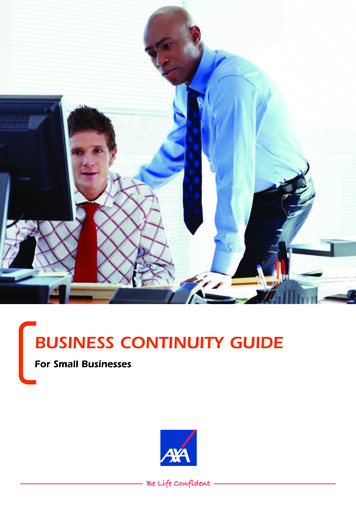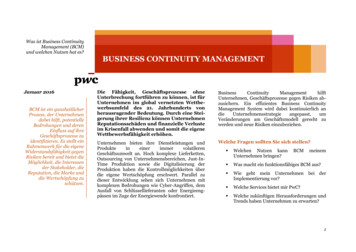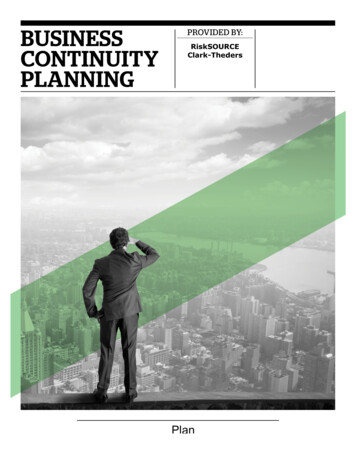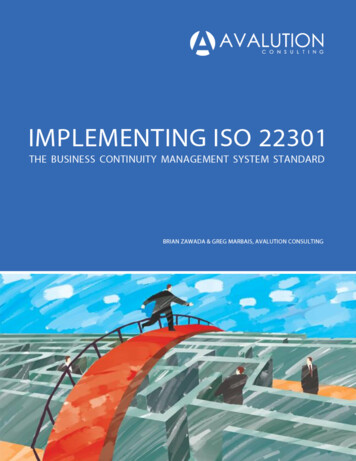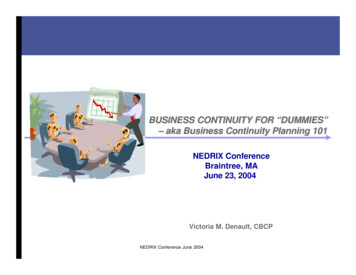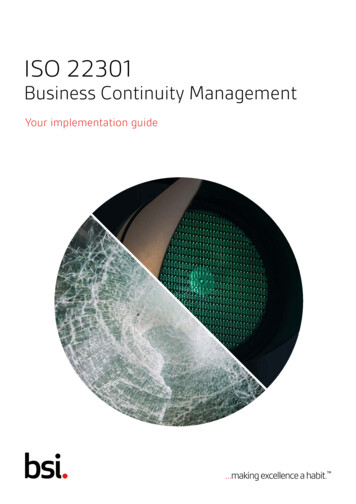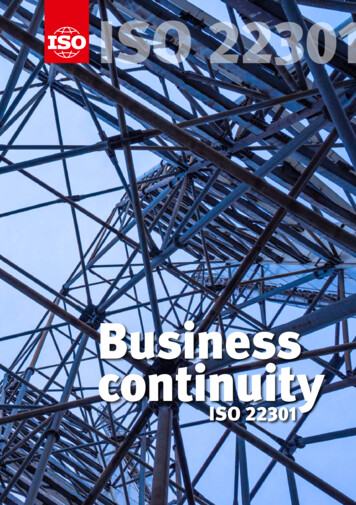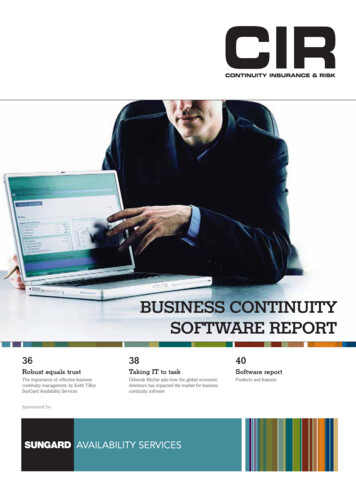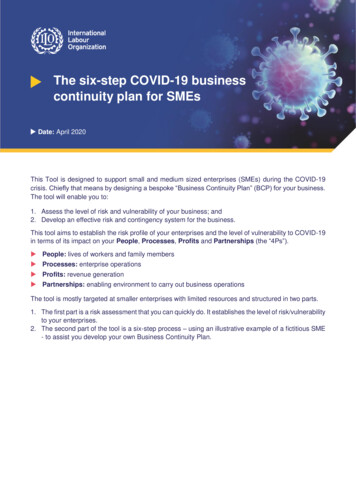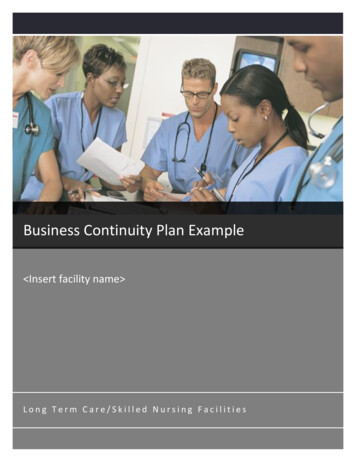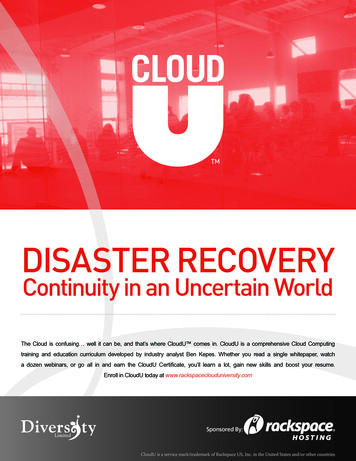
Transcription
Disaster RecoveryContinuity in an Uncertain WorldThe Cloud is confusing well it can be, and that’s where CloudU comes in. CloudU is a comprehensive Cloud Computingtraining and education curriculum developed by industry analyst Ben Kepes. Whether you read a single whitepaper, watcha dozen webinars, or go all in and earn the CloudU Certificate, you’ll learn a lot, gain new skills and boost your resume.Enroll in CloudU today at www.rackspaceclouduniversity.comSponsored By:CloudU is a service mark/trademark of Rackspace US, Inc. in the United States and/or other countries
Table of ContentsIntroduction An Experiential Basis Definitions – Setting the Context 123Business Continuity 3Disaster Recovery 3High Availability 3Disaster Recovery Does Not Equal High AvailabilityDeveloping a Disaster Recovery Plan 5IntroductionDisasters are an inevitable certainty for any organization—Develop the Contingency Planning Policy Statement 5but while inevitable, disasters are also generallyConduct the Business Impact Analysis (BIA) 5unpredictable. The best strategy then in the face ofIdentify Preventative Controls 5inevitable but uncertain negative events is to have a holisticDevelop Recovery Strategies 5plan that sets out the process by which an organization canDevelop an IT Contingency Plan 5return to normal operations after a disaster.Plan Testing, Training and Exercises 5Plan Maintenance 5This paper will define some core concepts around disaster79recovery, contrast it with the related but distinct field ofSuitability for Purpose Infrastructure – Cloud as an Agility Gain Data is Critical 10Don’t Forget the People 11Multiple Strategies for Multiple Workloads 12“Big Iron” Mission Critical Applications 12Mission Critical Applications Running on Windows orLinux Servers 12Non Mission Critical Generic Applications 12Conclusion About Diversity Analysis About Rackspace 131415High Availability, and give some key guidelines as to howan organization can plan, react and recover from a disaster.
An Experiential BasisIn September 2010, my home town, Christchurch New Zealand, was rockedby a major earthquake. In the twelve months that followed, many thousands ofearthquake events occurred including a significant event in February 2011 thatresulted in the near-total destruction of the downtown area and the loss of closeto 200 lives.In the period following the earthquake, I spent time talking with a wide variety oforganizations and exploring their individual technology situations before, duringand after the earthquake.This firsthand experience showed me that, rather than a ‘nice to have’ documentthat gets filed in a drawer and forgotten, a Disaster Recovery plan is a critical toolto ensure business continuity.I would like to acknowledge the many business people whom I spoke to abouttheir Disaster Recovery situation and salute their resilience in the face of almostoverwhelming events.Disaster Recovery—Continuity in an Uncertain World Diversity Limited, 2011 Non-commercial reuse with attribution permitted2
Definitions – Setting the ContextIn discussions with business people and Disaster Recovery experts, it became apparentthat many people confuse the various terms that relate to business continuity.It is necessary, before discussing a Disaster Recovery plan, to define some terms thatrelate to the space. The following are definitions developed from Wikipedia entries.Business ContinuityBusiness Continuity (BC) is the activity performed by an organization toensure that critical business functions will be available to customers, suppliers,regulators, and other entities that must have access to those functions. Theseactivities include many daily chores such as project management, system backups,change control, and help desk. Business continuity is not something implementedat the time of a disaster; Business Continuity refers to those activities performeddaily to maintain service, consistency, and recoverability.Disaster RecoveryDisaster Recovery (DR) refers to the process, policies and procedures relatedto preparing for recovery or continued operation of technology infrastructurecritical to an organization after a natural or human-induced disaster. Disasterrecovery is a subset of Business Continuity. While business continuity involvesplanning for keeping all aspects of a business functioning in the midst ofdisruptive events, Disaster Recovery focuses on the IT or technology systems thatsupport business functions.High AvailabilityHigh Availability (HA) is a system design approach and associated serviceimplementation that ensures a prearranged level of operational performance willbe met during a contractual measurement period. Setting up a High Availabilityenvironment seeks to mitigate the need for Disaster Recovery; if systems arearchitected to be highly available, they are less likely to fail in the event of anatural or man-made disaster.Disaster Recovery—Continuity in an Uncertain World Diversity Limited, 2011 Non-commercial reuse with attribution permitted3
Disaster Recovery Does Not Equal HighAvailabilityIt is important to reiterate the distinction between High Availability (HA) andDisaster Recovery (DR). HA’s focus is targeted to ensuring minimal interruptionsand therefore involves a lot of activity around replication, redundancy andautomated processes to manage the two.DR on the other hand relates to the timely recovery of data and processesfollowing an incident. The time to recovery will vary depending on the type ofdata and the situation and hence DR will include a broad range of approaches,typically involving some mix of automated preparation for and manualintervention during an incident.Cloud Computing with its economies of scale, speed and agility is well suited toDisaster Recovery functions and anecdotal evidence suggests that DR is one areathat organizations are looking to move rapidly to the Cloud.Disaster Recovery—Continuity in an Uncertain World Diversity Limited, 2011 Non-commercial reuse with attribution permitted4
Developing a Disaster Recovery PlanThe National Institute for Standards and Technology has developed a framework forplanning DR and other functions. The Contingency Planning Guide for InformationTechnology Systems1 lists the following seven steps to disaster preparation:Develop the Contingency Planning PolicyStatementA formal department or agency policy provides the authority and guidancenecessary to develop an effective contingency plan.Conduct the Business Impact Analysis (BIA)The BIA helps to identify and prioritize critical IT systems and components.Identify Preventative ControlsMeasures taken to reduce the effects of system disruptions can increase systemavailability and reduce contingency life cycle costs. High Availability architecturesfit in here.Develop Recovery StrategiesThorough recovery strategies ensure that the system may be recovered quicklyand effectively following a disruption.Develop an IT Contingency PlanThe contingency plan should contain detailed guidance and procedures forrestoring a damaged system.Plan Testing, Training and ExercisesTesting the plan identifies planning gaps, whereas training prepares recoverypersonnel for plan activation; both activities improve plan effectiveness andoverall agency preparedness.Plan MaintenanceThe plan should be a living document that is updated regularly to remain currentwith system enhancements.Disaster Recovery—Continuity in an Uncertain World Diversity Limited, 2011 Non-commercial reuse with attribution permitted5
The NIST approach is tailored to large government departments and hence has aformulaic approach towards DR planning, however even the smallest organizationcan apply a simplified planning approach towards DR that sees them assess therisks, plan the approach towards DR and ensure the DR plan is regularly testedand updated.It is important to note that a DR plan that is overly complex for the type oforganization and situation using it can be worse than having no DR plan at all.Organizations should always err on the side of simplicity when it comes to DR.Experience has shown that in times of crisis people are more able to follow a shortconcise plan than one that is lengthy and complex.Disaster Recovery—Continuity in an Uncertain World Diversity Limited, 2011 Non-commercial reuse with attribution permitted6
Suitability for PurposeAll organizations have a wealth of information types, from the highly critical tothe relatively unimportant. For example a system that holds data for an externallyfacing e-commerce solution is more critical than a payroll system that is onlyaccessed once a month.One of the key parts of planning therefore is to develop a list of the differentprocesses an organization needs to carry out its core business and the systemsthat drive those processes.The aim of this stage is to ensure that organizations have DR strategies in placethat are appropriate for them. This can be graphically predicted by plotting thecost of a disruption against the cost to recover. Any system where the cost torecover is lower than the cost of the disruption will likely be a good candidate fora DR system that ensures recovery within the particular timeframe. For a payrollsystem this timeframe may be a couple of weeks, in the case of e-commerce it maybe mere minutes.CostCost ofDisruptionCost toRecoverTimeIt is important to remember that DR does not simply concern itself with thereplacement of hardware systems; rather it looks holistically at the OUTCOMES anorganization wishes to achieve and maps the component parts of those outcomes.Disaster Recovery—Continuity in an Uncertain World Diversity Limited, 2011 Non-commercial reuse with attribution permitted7
It is no use having a DR system that replaces lost infrastructure only to realize thatkey personnel are needed to run the system or that the core data with which thesystem operates is missing.A Disaster Recovery system should also include documentation of key roles andresponsibilities, an explanation of how personnel process the particular operation athand and some thoughts around the assurance of continuity of data. It is the secondand third aspects of DR – infrastructure and data – that Cloud can help with.Disaster Recovery—Continuity in an Uncertain World Diversity Limited, 2011 Non-commercial reuse with attribution permitted8
Infrastructure – Cloud as an Agility GainIn previous CloudU whitepapers we have written at length about the impact thatCloud Computing has in terms of agility. Instead of having to undergo a lengthyrequisition process to install a new server, administrators can simply “spin up” anew server with a Cloud Computing provider. Indeed this creation of new serverscan even be automated and undertaken programmatically.While in a particularly large disaster, it may take a lengthy period of time for areplacement physical internet connection to be obtained, more and more of theinfrastructure elements an organization needs to operate can be abstracted away fromthe organization and to the Cloud – making DR a quicker and less complex task.The traditional approach for organizations has been to have redundantinfrastructure within their own facilities. For a small business this may meansimply a spare server in a cabinet somewhere, while for a large enterprise it maymean a fully redundant data center.It’s not difficult to see that, across the spectrum of organizational size, an in-houseredundant system is expensive, complex and resource intensive to maintain. Byusing a Cloud-based approach towards DR organizations can minimize DR costsoutside of disaster time, secure in the knowledge that many key systems can becreated at will.Disaster Recovery—Continuity in an Uncertain World Diversity Limited, 2011 Non-commercial reuse with attribution permitted9
Data is CriticalData is unique. Whereas it is possible to replace a physical server with a virtualone and have the system maintain functionality, without core data, a system islargely useless. Financial records, technical documentation and other core digitalassets can be critical to Disaster Recovery and hence a DR plan needs to thinkabout data replication.This is another example where Cloud can provide value – organizations canpursue a strategy that sees them replicate data in multiple locations. In this way,and in the event of a disaster, they are able to get back up and running quicklyonce applications are brought back up to speed. This approach of consideringboth application recovery and data recovery will stand an organization in goodstead should the unfortunate occur.Disaster Recovery—Continuity in an Uncertain World Diversity Limited, 2011 Non-commercial reuse with attribution permitted10
Don’t Forget the PeopleAny Disaster Recovery plan needs to be holistic in its approach and part of thisis ensuring that the plan takes into account the people element in recovery.There is little use in having applications and data running as normal if there is nodocumentation that allows people to take over the running of these applications.Organizations need to ensure they have clear and detailed standard operatingprocedures that outline how applications and processes run to ensure that DR canbe as painless as possible.Disaster Recovery—Continuity in an Uncertain World Diversity Limited, 2011 Non-commercial reuse with attribution permitted11
Multiple Strategies for Multiple WorkloadsOne key aspect of Disaster Recovery that needs to be stressed is the fact that notone type of solution fits all different applications and data types. Some classes orworkloads that organizations need to think about include mission critical “bigiron” applications, mission critical applications running on Windows or Linuxservers and generic applications that are not mission critical.“Big Iron” Mission Critical ApplicationsSo called “Big Iron” applications, those that run on traditional mainframecomputers, are complex from a DR perspective, both because of their level ofmission criticality, but also because they tend to run on specific hardware andoften run specialized operating systems and environments.DR for this class of application tends to rely on either on-premises or co-locatedreplication that can meet the highly specific needs of these workloads.Mission Critical Applications Running onWindows or Linux ServersThese applications lend themselves well to Cloud DR. It is a relatively trivial taskto architect a cloud environment on which sit replications of these applicationsthat can readily be turned on when needed. Alongside this replication of theapplications, organizations need to consider the replication of application data toensure business continuity.An individual business’ decision on whether to run DR for these workloads in thepublic or the private cloud will largely rest on their own internal decision makingprocesses about Cloud – we covered the different options around public andprivate Clouds in a previous CloudU paper.2Non Mission Critical Generic ApplicationsThe DR plan will indicate the thresholds for these applications in terms of howmuch downtime is acceptable and this will indicate the particular strategy forthese applications. However generally these applications can pursue a DR strategythat sees them use a Cloud target as a target for the backup.Disaster Recovery—Continuity in an Uncertain World Diversity Limited, 2011 Non-commercial reuse with attribution permitted12
ConclusionLike many things in life and technology, Disaster Recovery isn’t a case of blackand white. Rather it is a continuum where organizations need to think about thecriticality of particular data sets and the value they place in quick recovery ofthose workloads in a disaster event.Disaster Recovery is also an amalgam of both technical processes and proceduresand human ones; because of this it is critical for an organization to fully look intothe human elements of their Disaster Recovery plan to ensure this importantaspect has not been forgotten.Notwithstanding the breadth of possible approaches towards Disaster Recoverythat exist, it is fair to say that Cloud Computing has made a higher quality DRsetup to become more obtainable and as such it improves the overall disasterpreparedness an organization can achieve.Disaster Recovery—Continuity in an Uncertain World Diversity Limited, 2011 Non-commercial reuse with attribution permitted13
About Diversity AnalysisDiversity Analysis is a broad spectrum consultancy specializing in SaaS, CloudComputing and business strategy. Our research focuses on the trends in theseareas with greater emphasis on technology, business strategies, mergers andacquisitions. The extensive experience of our analysts in the field and our closerinteractions with both vendors and users of these technologies puts us in a uniqueposition to understand their perspectives perfectly and, also, to offer our analysisto match their needs. Our analysts take a deep dive into the latest technologicaldevelopments in the above mentioned areas. This, in turn, helps our clients stayahead of the competition by taking advantage of these newer technologies and,also, by understanding any pitfalls they have to avoid.Our Offerings: We offer both analysis and consultancy in the areas relatedto SaaS and Cloud Computing. Our focus is on technology, business strategy,mergers and acquisitions. Our methodology is structured as follows: Research Alerts Research Briefings Whitepapers Case StudiesWe also participate in various conferences and are available for vendor briefingsthrough Telephone and/or Voice Over IP.Disaster Recovery—Continuity in an Uncertain World Diversity Limited, 2011 Non-commercial reuse with attribution permitted14
About RackspaceRackspace Hosting is the service leader in Cloud Computing, and a founder ofOpenStack , an open source Cloud platform. The San Antonio-based companyprovides Fanatical Support to its customers, across a portfolio of IT services,including Managed Hosting and Cloud Computing. Rackspace has beenrecognized by Bloomberg BusinessWeek as a Top 100 Performing TechnologyCompany and was featured on Fortune’s list of 100 Best Companies to Work For.The company was also positioned in the Leaders Quadrant by Gartner Inc. in the“2010 Magic Quadrant for Cloud Infrastructure as a Service and Web Hosting.”For more information, visit www.rackspace.com.About the AuthorBen KepesBen Kepes is an analyst, an entrepreneur, a commentator and a business adviser.His business interests include a diverse range of industries from manufacturingto property to technology. As a technology commentator he has a broad presenceboth in the traditional media and extensively online. Ben covers the convergenceof technology, mobile, ubiquity and agility, all enabled by the Cloud. His areas ofinterest extend to enterprise software, software integration, financial/accountingsoftware, platforms and infrastructure as well as articulating technology simplyfor everyday users. More information on Ben and Diversity Limited can be foundat http://diversity.net.nzDisaster Recovery—Continuity in an Uncertain World Diversity Limited, 2011 Non-commercial reuse with attribution permitted15
Endnotes[1] [2] http://broadcast.rackspace.com/hosting knowledge/whitepapers/Creative Configurations Whitepaper.pdf
Cloud Computing with its economies of scale, speed and agility is well suited to Disaster Recovery functions and anecdotal evidence suggests that DR is one area that organizations are looking to move rapidly to the Cloud. Disaster Recovery—Continuity in an Uncertain World 5
